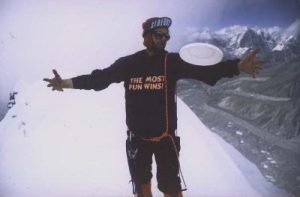 Written by Larry W. Imperiale
Written by Larry W. Imperiale
Background
Crushed…My first big prelims in Vancouver 78, and I lost a half-point on the variety check-off sheet because I didn’t do a brush and another half-point for not doing a roll. I figured I better work on this, and by Fall 1979 I had basic brushes and rolls down, thanks to Corey Basso and Skippy Jammer. But it wasn’t until I became a bench-warmer for Stanford Ultimate that I jumped to the next level with these skills by brushing and rolling on the sidelines.
Roll/Brush Fundamentals
1. Play by yourself often, practicing rolls and brushes where you have room to run and hopefully some, but not necessarily nice, wind. Visit San Diego, Santa Barbara, Santa Cruz, and other good wind-spots on nice wind-days as often as possible.
2. Face the wind. Know where you are in relation to the wind at all times. Learn to feel it like a sailor.
3. As Skippy says. remember that the object of a roll is not to get it from one hand to the other (bounce, bounce), but to roll it along the body as if it’s on Velcro, pulling it along your arms by moving your body in the opposite direction of the roll with “touch-Zs,” turbo rolls excepted.
4. Step into and follow-through on all brushes and kicks, as you would in tennis, volleyball or baseball.
5. Decrease the margin of error by wearing size twelve shoes for better surface-area for kicking. I’m a size 11.
6. Seriously, try brushing the disc steeper at times, a skill I learned watching Dave Marini and JJ (John Jewel) in 1978.
7. Step into the disc when brushing so if it goes too far you can get to it, always being ready for the missed hit….be on your toes and ready to sprint.
8. Don’t plan too much. The best part of this game is to take advantage of the hand dealt to you. If you plan to do a roll off of a set but it’s there for a kick or a scarecrow catch instead, go for what’s there. Don’t force it…go with the flow.
9. When you’re indoors, compensate for no wind by running faster to make your own wind, and by setting rolls and brushes steeper.
10. The force of the brush should be inversely proportional to the Zs on the disc. For example, you’re middle-jammer in a 3-person MAC-line (Midair Attitude Correction). The disc comes to you with a slight angle and high Z’s – just meet it with your hand or body part…it’s riskier to swing at it or brush it hard when it’s not needed. On the other hand, hit it harder if it has low Zs. Learn how to adjust the disk with a cuff as needed for better options in MAC-lines..
11. Cuff often when you’re sweaty and you have a steep, high Z disk.
12. The meek will not inherit the kick. Be aggressive. Pretend you’re the batter in 6th-grade kickball.
13. Play the spontaneous wind game with your friends, but also learn when to give space to your partner for individual moves. Go on “brush runs” with your partners. . Be like Magic Johnson and make the players around you better…Set up your partners with good, easy brush/roll/kick sets and watch great, difficult things happen that you won’t remember after you do them… this is a good sign. Communicate frequently before and after you jam to enhance these opportunities. Also talk during spontaneous times (e.g. all-mine, all-yours, coming, etc…).



